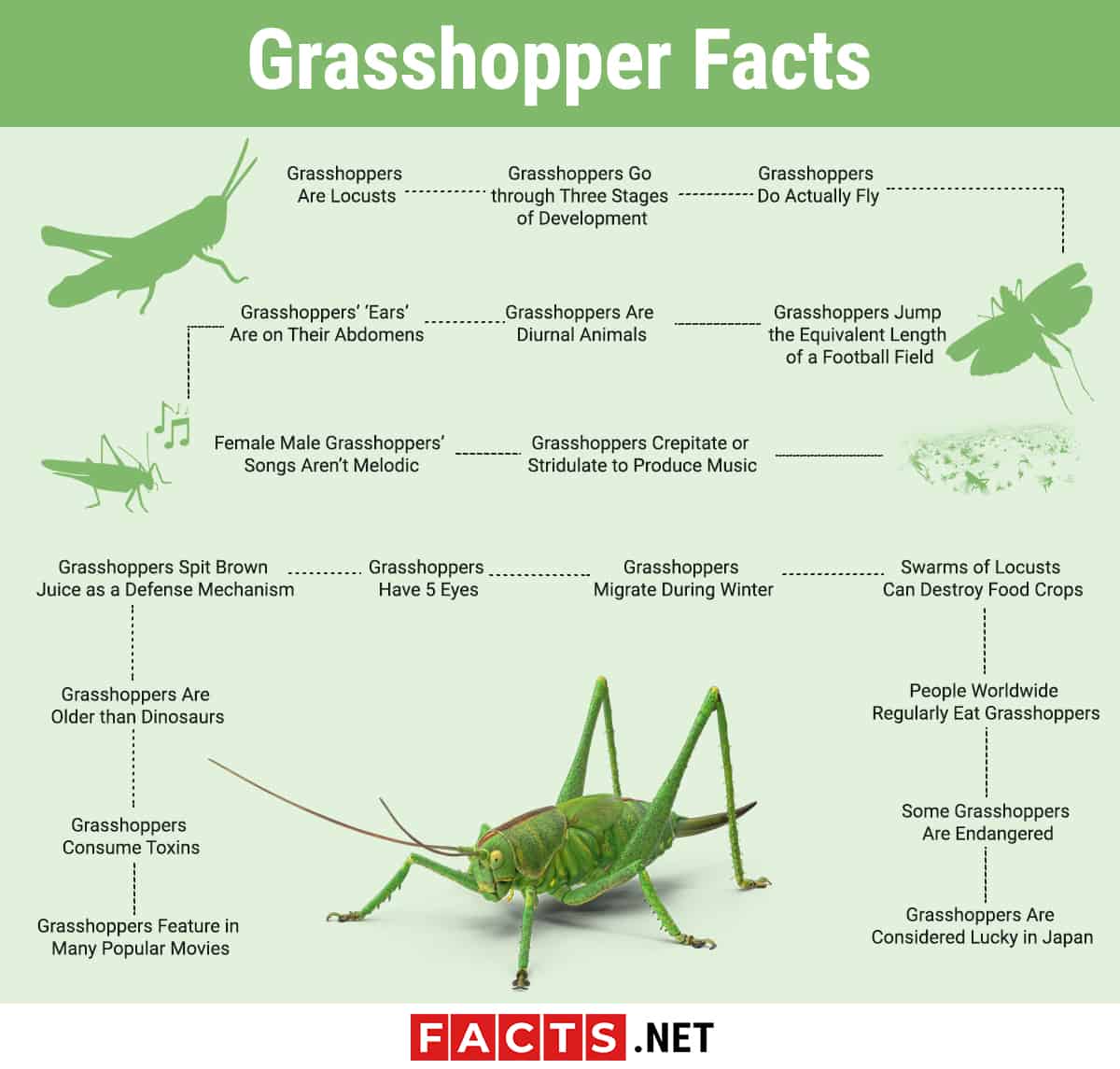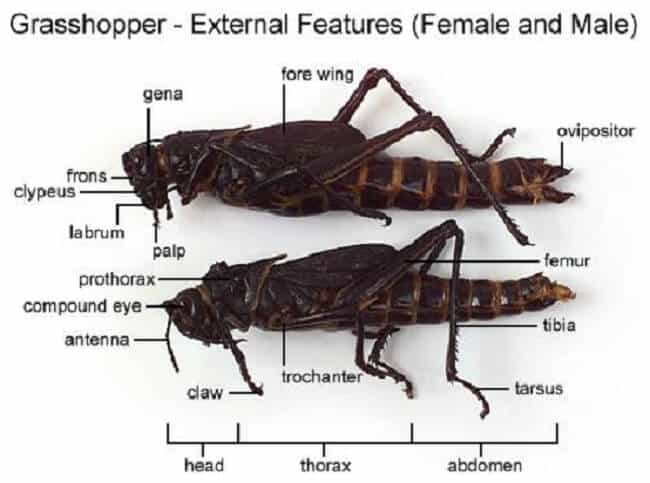
- Scientific Name: Caelifera
- Class: Insect
- Habitat: Gardens, crops, fields and forests in most climates
- Diet: Herbivore (plants)
- Length: From 0.5 to 5 inches
- Color: Brown, yellow, gray, and green
- Species: More than 11,000 known species exist worldwide
- Predators: Insects, birds, rodents and reptiles
- Lifespan: Approximately 1 year
- Conservation Status: Of Least Concern
- Classification: Grasshoppers Are Locusts
- Lifecycle: Grasshoppers Go through Three Stages of Development
- Flight: Grasshoppers Do Actually Fly
- Movement: Grasshoppers Jump the Equivalent Length of a Football Field
- Behavior: Grasshoppers Are Diurnal Animals
- Anatomy: Grasshoppers’ ‘Ears’ Are on Their Abdomens
- Sound: Female Male Grasshoppers’ Songs Aren’t Melodic
- Sound: Grasshoppers Crepitate or Stridulate to Produce Music
- Threats: Swarms of Locusts Can Destroy Food Crops
- Migration: Grasshoppers Migrate During Winter
- Grasshoppers Have 5 Eyes
- Grasshoppers Spit Brown Juice as a Defense Mechanism
- Grasshoppers Are Older than Dinosaurs
- Grasshoppers Consume Toxins
- People Worldwide Regularly Eat Grasshoppers
- Some Grasshoppers Are Endangered
- Grasshoppers Are Considered Lucky in Japan
- Grasshoppers Feature in Many Popular Movies
Grasshopper Facts Infographics

Grasshoppers Are Locusts

One of the grasshopper facts you may be surprised to learn is that grasshoppers and locusts are essentially the same thing. All these little critters belong to the order Orthoptera. We have come to refer to some species as grasshoppers, and other species as locusts, but they are actually just variants of the same animal. Typically, when they migrate or fly in swarms, they are referred to as locusts.
Grasshoppers Go through Three Stages of Development
A grasshopper’s lifecycle consists of three stages of development: egg, nymph, and adult. Female grasshoppers lay pods containing several eggs in fall, and these then hatch in the spring. The baby grasshopper, known as a nymph, resembles a small adult grasshopper, but without wings. As a nymph grows in size, it will shed its skin about five or six times. It does this by swallowing a large amount of air to split the cuticle so it can break out its exoskeleton. Finally, the nymph develops wings in order to become an adult grasshopper.
Grasshoppers Do Actually Fly
Many people are under the false impression that grasshoppers tend to jump, and not fly. Although grasshoppers have powerful legs that enable them to jump very well, they jump primarily to give them a lift into the air. Grasshoppers do in fact have wings and are actually very strong fliers. The ability to fly is particularly useful when they are trying to escape predators. So a flying grasshopper is a very real thing!
Grasshoppers Jump the Equivalent Length of a Football Field

If we were equipped with the equivalent jumping power of a grasshoppers, we would be able to jump the length of a football field – or even more! That’s because grasshoppers can jump 20 times their body length. Grasshopper facts reveal that they are able to jump this far because they have powerful six-jointed legs that use a catapult design. In order to jump, a grasshopper will bend its hind legs at the knee, thereby slowly contracting its big flexor muscles. This potential energy is stored in a piece of cuticle in the knee, just like a spring. In order to jump, the grasshopper then relaxes its muscles, which causes the cuticle to release the stored energy (again, just like a spring). This catapults the grasshopper into the air. Suddenly long jump athletes don’t seem quite so impressive…
Grasshoppers Are Diurnal Animals
Grasshoppers are diurnal, which means they rest at night and are active during the day. This is largely because grasshoppers need to absorb sunlight in order to raise their body temperature so that they have their required energy. This then enables them to be active during the day. However, they are also known to sometimes feed at night. Midnight snack anyone?
Grasshoppers’ ‘Ears’ Are on Their Abdomens
One of the most intriguing grasshopper facts is that a grasshopper’s ‘ears’ are located on its abdomen. On either side of the first abdominal segment, just beneath the wings, is a simple eardrum. These eardrums, called tympana, consist of membranes that vibrate in response to sound waves. The tympanum enables the grasshopper to hear the noises emitted by other grasshoppers.
Female Male Grasshoppers’ Songs Aren’t Melodic

Because grasshoppers have tympana organs, they can hear and detect any changes in the intensity and rhythm of the sounds that they hear. However, because these tympana are very rudimentary auditory organs, grasshoppers are in fact unable to discern differences in pitch. Therefore, the different species of grasshopper have distinctive rhythms to their songs. This enables them to distinguish between the different species so that males and females can find partners from their own species in order to mate. Male grasshoppers are fortunate that the females rely on rhythm to find mates, because male grasshoppers’ songs are not known to be particularly melodic!
Grasshoppers Crepitate or Stridulate to Produce Music
Most of us are probably familiar with the sound of grasshoppers in the garden. However, one of the most surprising grasshopper facts involves the way in which these insects create these songs. Most male grasshoppers stridulate in order to produce music. This means they rub their hind leg against their forewing. Special pegs located on the inside of their hind legs come into contact with the thickened edge of their forewing. This works in a similar way to a percussion instrument, producing the characteristic grasshopper sound. Other grasshoppers crepitate when making their music. This applies to band-winged grasshoppers, which snap their wings loudly while they are in flight. Now that’s in-flight music with a difference!
Swarms of Locusts Can Destroy Food Crops
A grasshopper will eat approximately half its body weight in plant material every day. That might sound like a lot, but a solitary grasshopper won’t cause that much damage. It’s when they are in swarms that they become a potential threat. One of the more unfortunate grasshopper facts is that the combined effect from a swarm feeding on plants can completely defoliate an area. Farmers’ crops are then destroyed, including important sources of food. Grasshoppers incur damage in grazing lands to the sum of $1.5 billion every year in the US alone.
Grasshoppers Migrate During Winter
Although migration is something that we typically associate with birds, grasshoppers also migrate during the colder months of the year. They tend to migrate in large groups, or swarms. One of the most astonishing grasshopper facts is that a single swarm can consist of millions, or even billions, of grasshoppers! Migration enables grasshoppers to find better sources of food during the winter months when crops are scarcer. Incredibly, grasshoppers can remain in the air for as long as three days without landing.
Grasshoppers Have 5 Eyes
Grasshoppers have certain anatomical features that are common to all insects. A grasshopper’s body consists of three parts: the head, thorax and abdomen. Grasshoppers also have six legs, two antennae and two pairs of wings. These thin antennae are usually the length of the grasshopper’s body, although they can be longer. What you probably didn’t know is that grasshoppers are equipped with five eyes. There is a large eye on either side of a grasshopper’s head, each equipped with thousands of lenses. This enables grasshoppers to see in all directions. A grasshopper also has three smaller eyes, one at the base of each antenna and one between the two antennae. The purpose of these three smaller eyes is as yet unknown by scientists.
Grasshoppers Spit Brown Juice as a Defense Mechanism
One of the most distasteful grasshopper facts is that grasshoppers are known to spit brown juice as a means of defense. It is thought that they do this to repel predators. In the past, grasshoppers were associated with tobacco crops, which led people to say that this brown liquid was actually tobacco juice. However, this is not the case. So, there’s no need to place spittoons in your gardens for these little critters.
Grasshoppers Are Older than Dinosaurs
The very first primitive grasshoppers appear in fossils from the Carboniferous Period, which occurred more than 300 million years ago. Later, during the Triassic Period, which occurred more than 200 million years ago, the ancestors of the modern day grasshoppers evolved. This was at the same time that the first reptiles appeared on Earth. Although most of this information is gleaned from grasshoppers preserved in fossils, some grasshopper nymphs were preserved in amber.
Grasshoppers Consume Toxins
There are a few species of grasshoppers that actually feed on toxic plants. One of the most fascinating grasshopper facts is that, strangely enough, this actually works to their advantage. These grasshoppers contain the toxins in their bodies, which they then utilize as a form of protection: their bodies are brightly colored, which warns predators that these insects are full of toxins, and are unappetizing.
People Worldwide Regularly Eat Grasshoppers
<> refers to the eating of insects. Grasshoppers and locusts have been a regular part of many people’s diets for as long as we can remember. In the Bible, St John the Baptist was reputed to eat locusts and honey in the wilderness. Grasshoppers are a regular source of protein in many parts of Asia, Africa and America. For example, chapulines is a Mexican dish consisting of sautéed grasshoppers. Chapulines fundido is a type of grasshopper fondue. Yum! Are you still feeling hungry?
Some Grasshoppers Are Endangered
Although the conservation status of grasshoppers in general is of least concern, there are some species of grasshopper that are in fact considered to be endangered. This is primarily due to a loss of their natural habitat which has occurred as a result of urban development and an increase in agriculture.
Grasshoppers Are Considered Lucky in Japan
As unusual as this may sound, grasshoppers are considered to be a sign of good luck in Japan. In general, the green grasshopper is associated with fresh beginnings, growth, health, rejuvenation, youth, nature, adventure and sentimentality.
Grasshoppers Feature in Many Popular Movies
A Bug’s Life is a well-known and much-loved animated film by Pixar. The villains in this movie are actually grasshoppers! These grasshoppers are depicted as greedy creatures. The main antagonist is a grasshopper named Hopper, who is voiced by Kevin Spacey. Hopper also appeared in the film It’s Tough To Be A Bug!, where his voice was provided by Andrew Stanton.
Grasshopper Facts – Facts about Grasshoppers Summary
 Thousands of species of grasshopper live in almost every climate on Earth. These diurnal insects have several distinctive features, including their ability to jump and fly very well. Even though they can be crop pests in swarms, they are seen as a delicacy or good luck charm in different cultures.
Thousands of species of grasshopper live in almost every climate on Earth. These diurnal insects have several distinctive features, including their ability to jump and fly very well. Even though they can be crop pests in swarms, they are seen as a delicacy or good luck charm in different cultures.
Was this page helpful?
Our commitment to delivering trustworthy and engaging content is at the heart of what we do. Each fact on our site is contributed by real users like you, bringing a wealth of diverse insights and information. To ensure the highest standards of accuracy and reliability, our dedicated editors meticulously review each submission. This process guarantees that the facts we share are not only fascinating but also credible. Trust in our commitment to quality and authenticity as you explore and learn with us.
